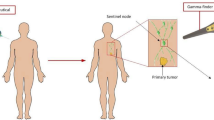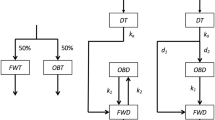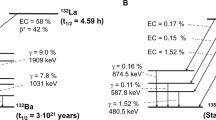Abstract
IN the course of a survey of positron-emitting radioactive isotopes for potential use in external localization of human brain tumours1, zirconium-89 (half-life, 79 hr.) was studied. Positrons with a maximum energy of about 0.9 MeV. and gamma rays of 0.9 MeV. energy are emitted. Previous animal studies employing zirconium salt solutions in metal displacement therapy of radioactive plutonium poisoning indicated a rapid excretion of the zirconium in the urine2. However, other investigations in animals suggested that various zirconium salts, when injected intravenously, formed colloidal aggregates which differed in distribution according to their particle-size. The larger aggregates were not rapidly cleared from the blood3.
This is a preview of subscription content, access via your institution
Access options
Subscribe to this journal
Receive 51 print issues and online access
$199.00 per year
only $3.90 per issue
Buy this article
- Purchase on Springer Link
- Instant access to full article PDF
Prices may be subject to local taxes which are calculated during checkout
Similar content being viewed by others
References
Brownell, G. L., and Sweet, W. H., Nucleonics, 11, (11), 40 (1953).
Schubert, J., Science, 105, 389 (1947).
Gofman, J. W., J. Lab. Clin. Med., 34, 297 and 305 (1949).
Shure, K., and Deutsch, M., Phys. Rev., 82, 122 (1951).
Author information
Authors and Affiliations
Rights and permissions
About this article
Cite this article
MEALEY, J. Turn-over of Carrier-free Zirconium-89 in Man. Nature 179, 673–674 (1957). https://doi.org/10.1038/179673a0
Issue Date:
DOI: https://doi.org/10.1038/179673a0
This article is cited by
-
Spatio-temporal biodistribution of 89Zr-oxine labeled huLym-1-A-BB3z-CAR T-cells by PET imaging in a preclinical tumor model
Scientific Reports (2021)
-
Production of 88,89Zr by proton induced activation of natY and separation by SLX and LLX
Journal of Radioanalytical and Nuclear Chemistry (2009)
-
Zirconium
Biological Trace Element Research (1992)
-
Contribution to the Pathogenesis of Zirconium Granulomas in Man**From the Division of Dermatology, Department of Medicine, University of California School of Medicine, San Francisco, California.
Journal of Investigative Dermatology (1960)
Comments
By submitting a comment you agree to abide by our Terms and Community Guidelines. If you find something abusive or that does not comply with our terms or guidelines please flag it as inappropriate.



